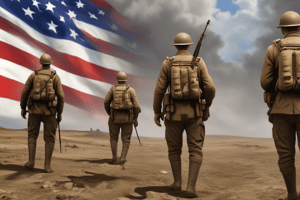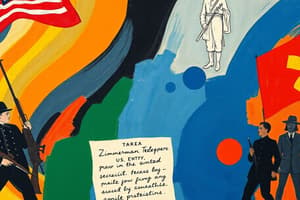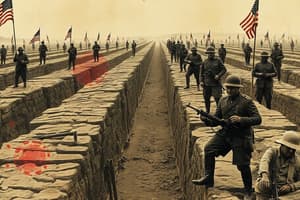Podcast
Questions and Answers
What was the main reason for the United States to enter World War I?
What was the main reason for the United States to enter World War I?
Unrestricted German submarine warfare.
What was the goal of the German Ludendorff Offensives in 1918?
What was the goal of the German Ludendorff Offensives in 1918?
- To secure key resources in Eastern Europe and expand their territory
- To capture Paris and end the war quickly
- To force a surrender of the Allied forces before the US could fully mobilize and join the war (correct)
- To weaken the Allied forces in preparation for a counteroffensive
The Treaty of Versailles was seen as a just and balanced peace agreement by Germany.
The Treaty of Versailles was seen as a just and balanced peace agreement by Germany.
False (B)
What was the main goal of the May 4th Movement in China?
What was the main goal of the May 4th Movement in China?
What are some of the key takeaways from World War I and the post-war era?
What are some of the key takeaways from World War I and the post-war era?
What was the main cause of the Cold War?
What was the main cause of the Cold War?
What were some of the key developments in the Cold War that contributed to heightened tension?
What were some of the key developments in the Cold War that contributed to heightened tension?
What were the key concepts of Marcus Garvey's Pan-Africanism?
What were the key concepts of Marcus Garvey's Pan-Africanism?
What were the main causes of the Great Depression:
What were the main causes of the Great Depression:
Name two major Cold War Conflicts?
Name two major Cold War Conflicts?
Flashcards
US Entry into WWI
US Entry into WWI
The United States joined World War I in 1917, largely due to German unrestricted submarine warfare and the Zimmerman Telegram.
Eastern Front
Eastern Front
The major theatre of war on the Eastern Europe during World War I, mainly between the Russian Empire and the Central Powers.
Ludendorff Offensives
Ludendorff Offensives
A series of German offensives in 1918, aimed at achieving victory in World War I before the United States could fully mobilize.
Hundred Days Offensive
Hundred Days Offensive
Signup and view all the flashcards
Paris Peace Conference
Paris Peace Conference
Signup and view all the flashcards
Treaty of Versailles
Treaty of Versailles
Signup and view all the flashcards
Women's Rights
Women's Rights
Signup and view all the flashcards
Existentialism
Existentialism
Signup and view all the flashcards
Irish War of Independence
Irish War of Independence
Signup and view all the flashcards
Chinese Civil War
Chinese Civil War
Signup and view all the flashcards
Marcus Garvey
Marcus Garvey
Signup and view all the flashcards
Great Depression
Great Depression
Signup and view all the flashcards
Fascism
Fascism
Signup and view all the flashcards
World War II
World War II
Signup and view all the flashcards
Atomic Bomb
Atomic Bomb
Signup and view all the flashcards
Divided Europe
Divided Europe
Signup and view all the flashcards
Decolonization
Decolonization
Signup and view all the flashcards
Globalization
Globalization
Signup and view all the flashcards
Cold War
Cold War
Signup and view all the flashcards
Study Notes
US Entry into World War I
- Unrestricted submarine warfare, German U-boats attacking without warning, was a major reason.
- Sinking of American ships increased tensions with the US.
- Zimmerman telegram: Germany proposed an alliance with Mexico.
- Economic factors: Ensuring repayment of Allied loans, shaping the post-war peace settlement.
- Associated Power: US's role as an independent ally.
- American Expeditionary Forces (AEF) led by General Pershing.
Eastern Front
- Bolshevik Revolution (1917) led by Lenin and Trotsky.
- Trotsky's slogan: "No war, no peace."
- Treaty of Brest-Litovsk (1918): Ended Russia's involvement in the war.
- Treaty of Versailles reversed Russia's involvement.
The Ludendorff Offensives (1918)
- Spring Offensives: German attempts to win before US impact.
- Transferred troops from Eastern to Western Front.
- Tactics: Stormtrooper units, short artillery barrages, infiltration.
- Failed to achieve decisive victory.
The Hundred Days Offensive (1918)
- US Contribution: 4 million troops mobilized, 1.3 million at the front.
- Timeline:
- August 8: "Black day for the German Army."
- November 11: Armistice signed.
- Key Battles: Meuse-Argonne.
Studying That Suits You
Use AI to generate personalized quizzes and flashcards to suit your learning preferences.




